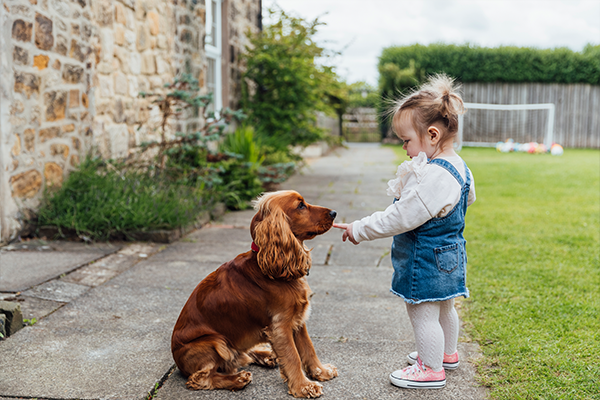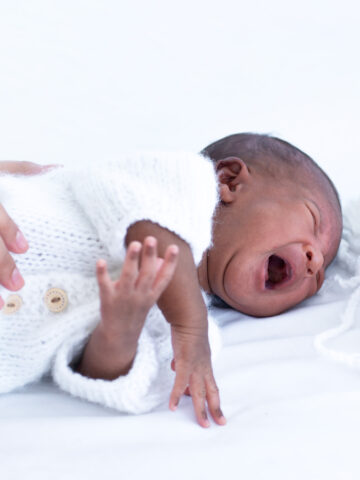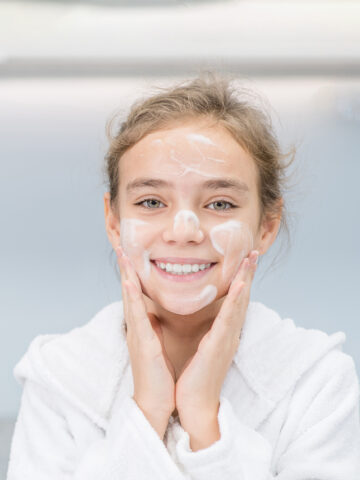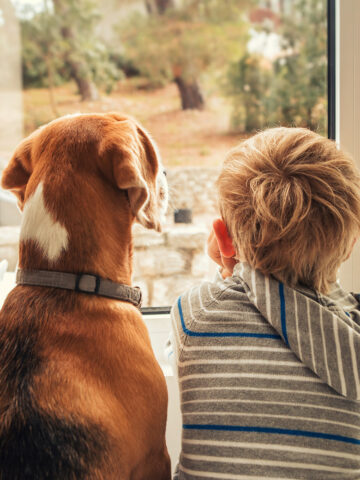2 Year Old Child Development Milestones
2-Year-Old Developmental Milestones
Children transition from babies to toddlers during their second year of life. They become more independent in daily activities like dressing/undressing themselves. They make major strides in communication, and their vocabulary increases slowly over the first 6 months and then expands quickly during the second 6 months. At this point, most 2 year old’s are able to use simple two-word sentences.
Doctors use certain milestones to tell if a toddler is developing as expected. There is a wide range of what’ is considered normal, so some children gain skills earlier or later than others. Toddlers who were born prematurely reach milestones later. Always talk with your doctor about your child’s progress.
How Much Will My 2-Year-Old Child Grow?
After a child’s second birthday, the rate of growth continues to slow. Two-year-olds are very active and begin to lose the appearance of a baby. While all children may grow at a different rate, the following indicates the average for 2-year-old boys and girls:
- Weight: average gain of about 4 to 6 pounds per year
- Height: average growth of about 2 to 3 inches each year
What Can My 2-Year-Old Child Do at This Age?
As your child continues to grow, you will notice new and exciting abilities that develop. While children may progress at different rates, the following are some of the common milestones your child may reach in this age group:
- Walks and runs well
- May jump awkwardly
- Begins to throw, kick and catch balls
- Can stand momentarily on one foot
- Climbs on playground structures
- Turns doorknobs and lids
- Begins to ride a tricycle
- Builds towers of 10 blocks by 3 years old
- All 20 teeth appear by 3 years old
- Appetite decreases greatly
- Has developed right- or left-handedness by 3 years old
- Turns pages in a book, one at a time
- Has good thumb and finger control
- Can drink through a straw
- Begins to have bladder and bowel control
- May still take one afternoon nap
- May sleep 10 to 12 hours at night
What Can My 2-Year-Old Child Say?
Speech development is very exciting for parents as they watch their children become social beings that can interact with others. Speech at this age is becoming clearer and the child begins to form sentences. While every child develops speech at his or her own rate, the following are some of the common milestones in this age group:
- Says about 200 to 300 words
- Begins to put three words together (subject, verb, object), for example “Me want ball”
- Names pictures
- May name some body parts
What Does My 2-Year-Old Child Understand?
While children may progress at different rates, the following are some of the common milestones children may reach in this age group:
- Understands possession, “Mine”
- Can tell his or her own age and name
- Knows if he or she is a boy or girl
- Counts up to three objects
- May begin to problem solve
How Does My 2-Year-Old Child Interact With Others?
While every child is unique and will develop different personalities, the following are some of the common behavioral traits that may be present in your child:
- Shows independence from parents
- Continues to play alongside others without interacting, called parallel play
- Acts as if other children are objects or toys
- Does not understand sharing
- Is negative and says “no” frequently
- Temper tantrums may continue
- Helps to get himself or herself dressed and undressed
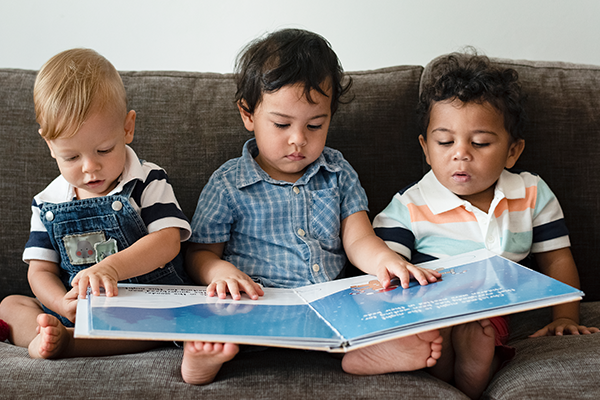
Movement and Coordination in a 2-year-old
As a child’s mobility improves so does their ability to investigate where they could not before. Once again, take a look around your home from a child’s vantage point and update childproofing measures to keep your child safe as their skills advance.
How Is My Child Moving?
About 6 months after taking their first steps, toddlers develop a more mature gait: they may hold their hands at their sides (rather than out in front for balance) and move with their feet closer together. They also tend to move their feet in a way that looks more like walking — moving from the heel to the toe.
During these months of practice, most toddlers take a few spills, but this is part of learning to walk. You cannot protect your youngster from every fall, but you can reduce the risk of injury by keeping exploration in safe areas away from sharp corners of furniture and other hazards.
After walking for a couple of months, your child will begin to feel more confident about walking and take on new challenges — such as picking up and carrying objects, moving while pulling a toy behind, and climbing stairs.
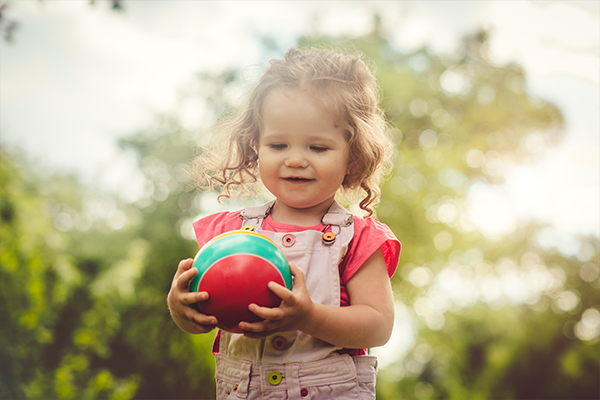
By the middle to end of their second year, your child may learn to run, start to kick a ball, and try to throw a ball. By 2 years, your child may jump in place.
How Can I Encourage My Child?
- Give your child ample things to do and see. Take walks around your yard and the neighborhood or visit a local playground. At home, you can make an obstacle course of pillows or boxes and encourage your child to walk, climb and crawl through it. Buy a few balls for kicking and throwing. Experts recommend that toddlers should:
- Get at least 30 minutes daily of structured (adult-led) physical activity like playing on the playground, going for a walk or being in a parent-and-child tumbling class
- Get at least 1 hour of unstructured free play each day when they can explore and play with toys
- Not be inactive for more than 1 hour at a time except when sleeping
- Have indoor and outdoor areas that meet or exceed recommended safety standards for all of their activities
- As their physical skills develop, toddlers also learn to use their hands more. There are many toys and craft supplies that can help your 2-year-old in this area. Some include:
- Paper and crayons
- Sculpting dough
- Stacking toys that kids can build up and knock down
- Simple puzzles
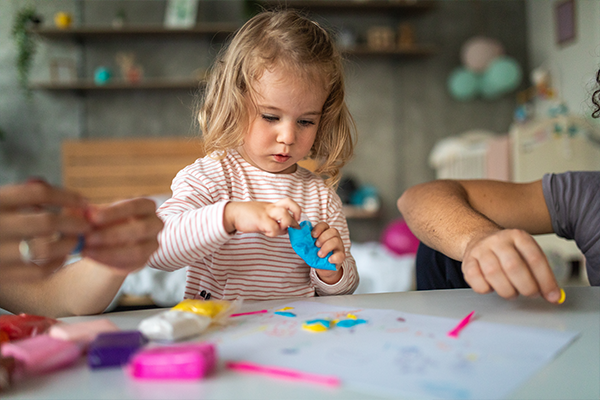
How Long Should My 2-Year-Old Child Sleep?
Toddlers have growing imaginations and are becoming more aware of their surroundings. This can start to interrupt their sleep. A 2-year old needs about 10-12 hours of sleep at night with 1-4 hours during the day for naptimes. This can include 1 or 2 daytime naps and can vary based on how your toddler acts for both naps. For example, if they fight the morning nap, then they might just be ready for an afternoon nap.
Check out our Healthy Sleep for Children for more info.
How Can I Help Increase My 2-Year-Old Child’s Learning And Emotional Security?
Consider the following as ways to foster the emotional security of your 2-year-old:
- Let your child have a choice when possible: for example, say, “Do you want a banana or an orange?”
- Let your child help around the house, such as dusting, sweeping or sorting laundry
- Read picture and story books with your child
- Help your child learn to wash his or her hands
- Let your child try to take off his or her own clothes and put on some simple clothes (i.e., clothes without buttons or zippers)
- Let your child play with blocks, balls, crayons and/or clay. Supervise play so that your child does not put objects in his or her mouth, ears, etc.
- Sing songs, play children’s music and dance with your child
- Look at family pictures with your child and tell a story
- Make cut-outs in a large cardboard box to pretend it is a house or car
- Use toys during bath time; have fun pouring water from one cup to another
- Let your child talk on a toy phone, or say a few words while you are talking on a real phone
- Play “follow the leader” games
- Teach body parts while dressing and bathing
- Let your child put stickers on paper to make a design
- Count things out loud to teach your child about numbers (i.e., count eggs in the carton, stairs as you go up, or fingers and toes)
- Play with soap bubbles
- Use toys that sort shapes, such as a circle, square or triangle
- Give your child a doll or teddy bear
- Read your child a book of rhymes
- Give your child a toy to ride
- Limit television and video time
- Provide out-of-home social experiences
Reviewed by Dr. Toya Tillis, Pomona Pediatrics, CHOC Primary Care – June 2021
Your child’s health is important at every stage. Visit CHOC Primary Care for pediatric services near you.
What's coming up for your child
Related articles for this age group
A CHOC pediatrician explains the causes of colic in babies, and offers tips to parents for helping their colicky baby.
When siblings Julissa and Joseph were diagnosed with the same rare congenital heart disease, CHOC stepped in to treat them both.
Should teens and preteens be using so many skincare products with fancy ingredients? A pediatric dermatologist answers parents’ questions.
11-year-old Isa had to relearn everything after treatment for FIRES, a rare epilepsy disorder. With help from CHOC rehab, he’s thriving.
A CHOC mental health expert demonstrates five coping tips for parents and caregivers through video, and discusses the importance of self-care.
A CHOC mental health expert helps parents guide their kids and teens through the loss of a family pet, and offers tips for dealing with grief.
